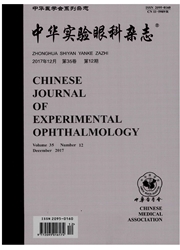

 中文摘要:
中文摘要:
目的观察体外培养人眼脉络膜黑色素细胞的生长状况,用透射电镜、细胞免疫化学染色鉴定其性质,为进一步研究脉络膜黑色素细胞及相关眼病提供模型。方法将脉络膜组织用胰蛋白酶与胶原酶多次消化,分离得到的细胞用F12培养液进行培养、传代、冻存和复苏。用透射电镜、细胞免疫化学染色鉴定细胞性质。结果初分离的脉络膜黑色素细胞呈棕色球状体,24h内贴壁。贴壁细胞渐变为双极、三极或树枝状,常有较长的分支,胞浆内含有棕黄色色素颗粒,传代后色素量保持稳定。电镜下可见细胞表面有少量微绒毛,胞浆内的黑素体沿胞膜分布或簇状分布。体外培养的脉络膜黑色素细胞S-100表达阳性,细胞角蛋白表达阴性。结论采用胰蛋白酶与胶原酶多次消化并在培养液中添加多种刺激因子,可建立人眼脉络膜黑色素细胞的有限细胞系。
 英文摘要:
英文摘要:
Objective Choroidal melanocytes are involved in the pathogenesis of a variety of eye diseases,and there are only a few attempts to culture choroidal melanocytes from human. The purpose of this study was to establish a method of culturing human choroidal melanocyte line. Methods Choroidal melanocytes were isolated from 4 eyeballs of 4 donors by trypsin-collagenase digestion. Isolated cells were cultured with F 12 medium supplemented with fetal bovine serum,basic fibroblast growth factor,isobutyl methylxanthine and cholera toxin. Transmission electron microscope and immunochemistry were used to identify and study the characteristics of human choroidal melanocytes. Results Separated choroidal melanocytes showed brown spheroplasts and attached in 24 hours. Attached cells displayed at the dipolar, tripolar or dentritic morphology. Yellow-brown pigment granules were seen in the cytoplasm,and melamin content remained stable after several passages. Ultrastructurally,sparing microvillus existed on the surface of cells,and melanosomes in the cytoplasm were exhibited along membrane or in clump. All of the cells in the cultures were positively stained for antibodies to S-100 but not cytokeratin. Conclusion Trypsin-collagenase digestion and medium supplemented with special factors are helpful for us to establish a human choroidal melanocyte line.
 同期刊论文项目
同期刊论文项目
 同项目期刊论文
同项目期刊论文
 期刊信息
期刊信息
